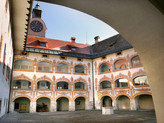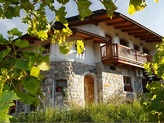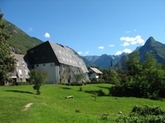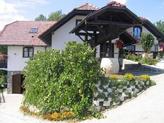- Alpe šport Vančar 10 2.7.2024, 16:35
- Pizzeria und Restaurant Paco 2 7 12.8.2023, 09:05
- Camp Natura Terme Olimia 6 9.8.2023, 21:52
SloveniaHolidays.com > Orte > Komen
Komen
Komen
Auf dem Weg über Hochebene Kras ziehen Komen, der im Zentrum von Komenski Kras liegt, und Karstdörfer wie Volčji Grad, Štanjel und andere, sicherlich Aufmerksamkeit. Dazwischen ist sicherlich am meisten Dorf Štanjel mit Steinhäusern, die auf dem Hügelhang gesammelt sind, bekannt. Komen ist mit 700-jähriger Geschichte heute Kultur- und Wirtschaftszentrum der Gemeinde. In der Zeit während der beiden Weltkriege ist Komen als bedeutendes touristisches Zentrum, wo Burger aus Triest, Monfalcone und sogar aus Venedig Urlaub und Sonntagsausflüge gemacht haben, bekannt geworden. Wegen günstigen Klimas ist Komen auch Heilzentrum geworden.
Photo
The valley of the river Branica (Kodreti, Dolanci, Čehovini, Koboli, Večkoti, Trebižani)
Gornja Branica Valley concludes northern edge of the Karst plateau where it descends to an altitude of 80 to 100m and continues to the southern edge of the Vipava Valley and the Vipava hills.
Attractons:
-Parochial church of Sv. Katarine in Kodreti
-A monumenunt to baron Andrej Čehovin in Dolanci
-Bridge above the torrent Raša in Koboli
-Several memorial plaques to NOB
-Ecclesial marks »pili« in Čehovini
Famous persons:
-Andrej Čehovin
KOBDILJ
Kobdilj is a grouped settlement on the northeastern edge of the Komen Karst, near the medieval village Štanjel. The biggest mark in local history is left by the Fabiani family, whichlived there from the 17th centoury.
Attractons:
-»Trg« in lower Kobdilju
-Fabiani'svilla in upper Kobdilju – ''Serzentova domačija''¨, house n0. 39.
-Pluricentenial mulberry
-A permanent water spring
-The church of St. George
-Fabiani path– a net of hiking trails from Kobdilj to Štanjel
Famous persons:
- Maks Fabiani
-Anton Mahnič
KOBJEGLAVA
The village community of Kobjeglava consists of the village Kobjeglava, which lies on the eastern part of the Komen plateau and a small village Tupelče which extends just behind the village Kobjeglava from Komen. According to popular interpretation, the name of the village Kobjeglava is associated with the name of the highest peak behind the village called »Kop«, which was head of other two peaks, therefore »Kop je glava« (Kop is the head) Kobjeglava. By another interpretation is the name associated with stables for horses and mares, hence the name »mare-head« (kobila-glava).
Attractons:
-Parochial church of sv. Mihael: the main altar of St.Mihael is one of the best Baroque stone altars in the wider Primorska region, made in 1768;
-NOB memorial: in a stylized form of karst home with a column, fountain, stone walls and a roof covered with škrle. Stones around the monument, connected by a chain, symbolizing the fallen fighters;
-hiking trails around the village.
Famous persons:
-Josip Abram
-Filip Abram
-Anton Rudež
HRUŠEVICA
Hruševica is a medium-sized village on the east side of the Komen Karst. The first data on settlement in the area dates back to the iron age period; since then there is a small fort– “debela griža”, which is unfortunately overgrown by a pine forest for almost a century. There was once a quarry, where they broke dark-gray Karst marble.
Attractons:
-The succursal Church of St. Joseph
-The statue of St. John Nepomucene
-A monument dedicated to those who fell serving in the Resistance Movement (NOB) in the centre of the village;
-roadside shrines.
TOMAČEVICA
Tomačevica is a smaller village, which extends east from Komen. Through the village goe san old pilgrimage route to the church of Virgin Mary »Obršljanske«, a few minutes outside the village.
Attractons:
-The succursal Church of the Virgin Mary »Oberšljanska«
-A commemorative plaque to the national hero Anton Šibelja Stjenka(on house number 6)
-Village walking path among pine trees on the Zajčevca hill.
-A monument dedicated to those who fell serving in the Resistance Movement (NOB) in the centre of the village
Famous persons:
-Anton Šibelja – Stjenka
KOMEN
Village Komen is mentioned for the first time in 1247. As an important administrative, economic, and cultural center, Komen began to flourish as early as the end 19th century, when crafts, a network of inns, shops and administrative functions began to emerge. The village famous in the period of Italian rule as an important tourist center where the inhabitants of Trieste, Monfalcone and even Venice came for their holidays and Sunday excursions.
Attractons:
-The Parish Church of St. George
-The main square with cultural center and a monument dedicated to those who fell serving in the Resistance Movement (NOB) and those who died in exile
-Former Villa Storici –
-The Austro-Hungarian military cemetery in the Forest of Draga.
SVETO PRI KOMNU
Sveto near Komen is mostly known for its church dedicated to St.Tilen(Giles) with special,octagonal main nave, a unique example of architecture of the 16th century in the wider area.
The village cemetery is also a first World War II, in which are buried most of the Hungarian soldiers.
Attractons:
-The Succursal Church of St. Giles
-An ancient lime tree: (around 500 years old) next to the church;
-Lokve: small water reservoirs;
-The Austro-Hungarian military cemetery;
-A walk through the village;
VOLČJI GRAD
Volčji Grad is a small village with very rich natural and cultural heritage, especially the rich legacy of quarrying. In the proximity of the village are the remains of an iron age fort, called »Debel Griža«, which is one of the best preserved forts in our territory from that period
Attractons:
-hill fort – Debela griža
-The Succursal Church of St. John the Baptist
-A walk through the village
-A series of roadside shrines at the beginning of the village
-The Stone Trail: a signposted educational trail through the village where you can learn something about the cultural and natural attractions of Volčji Grad
ŠKRBINA
A special historical mark was left by the 2. World war, becous in Škrbina were some outpost of the national liberalization movementand so today we can see a big number of commemorative plaques.
Attractons:
-The Parish Church of St. Anthony the Abbot;
-The Spacal home (house number 24)
-A number of commemorative plaques dedicated to those who fell serving in the Resistance Movement (NOB);
- A pilgrimage footpath on St. Catherine Hill with rest points of the Way of the Cross;
-The remains of the »Laz« homestead
-Foot train in the background of Isonzo Front.
GORJANSKO
Attractons:
-The Austro-Hungarian cemetery of World War I: this is the largest cemetery of the Austro-Hungarian army for soldiers lost in the Isonzo Front. As far as 10,000 soldiers of different nationalities are buried here;
-The house where linguist and folk material collector, Karel Štrekelj, and the agricultural expert, Anton Štrekelj, were born;
-Water reservoir with drinking troughs: uniwue example of technical and cultural heritage is believed to have been built in 1906 to provide drinking water for cattle. The villagers directed the rainwater into a channel and then into sinks from where the water ran in to a cistern with a capacity of 650m3.
BRJE PRI KOMNU
Attractons:
-The village well: next to the bus stop. Its rim contains a carved motif of two people nest the well, but the motif in most likely to be a Biblical motif of Jesus and a Samarian woman;
-Four Austro-Hungarian military cemeteries;
-A commemorative plaque dedicated to the navy unit in Škofi from World War II: housenumber 4;
BRESTOVICA
Brestovica pri Komnu is famous for a series of natural phenomena: sinkholes and Karst caves, among which the most important are Dolenjca and Drča Jama, which are connected to an underground tributary of the Timava River. In Klariči there is a water pumping station fot the Karst water supply and provides drinking water for the inhabitants of the Karst and Slovene Istria.
Attractons:
-The succursal Church of St. Anastasia: it was built in either the 15th or 16th centuries.
-Grofova jama (Grof's cave): it is a fosil cave which in on a slope and have five entrances. The cave was set up as a shelter for Austro-Hungarian soldiers.
-Moritz Cavern: in a sinkhole close to Grofova jama, wherean Austro-Hungarian artillery post was based;
-Iron age hill fort which sorrounds the Gredine hill in the immediate proximity of Grmada above Dolnja Brestovica;
-»Jerihovca« or Valska jama: in World War I, the cave served as a hospital for Austro-Hungarian soldiers.
 Kultur und Tradition – unsere Museen und andere Kultursehenswürdigkeiten
Kultur und Tradition – unsere Museen und andere Kultursehenswürdigkeiten Begeben Sie sich auf einen etwas andren Ausflug – einen, der die Kultur mit einbeziehen wird. Hier sind unsere Vorschläge.
 Im Gasthaus Pri Marjotu Kojsko bieten wir alles Nötige für ihr perfektes Erlebnis in Goriška Brda (deutsch: Görzer Hügelland).
Im Gasthaus Pri Marjotu Kojsko bieten wir alles Nötige für ihr perfektes Erlebnis in Goriška Brda (deutsch: Görzer Hügelland).Vorzügliches Essen, heimische Weine, ausgezeichnete Beherbergung und hervorragender Ausgangspunkt für ihre Ausflüge im Hügelland.
 Kongresstourismus
KongresstourismusBenötigen Sie einen Räume für Seminare, Vorlesungen oder ein Teambuilding-Event? Schauen Sie sich die besten Anbieter solcher Dienstleistungen hier >>
 Appartements Kaninska vas
Appartements Kaninska vas
Alle Appartements Kaninska vas liegen auf einer sonnigen Terrasse in unmittelbarer Nähe des Zentrums von Bovec.
 FÜR IHR WOHLBEFINDEN UND EINE POSITIVE AUSSTRAHLUNG
FÜR IHR WOHLBEFINDEN UND EINE POSITIVE AUSSTRAHLUNGWir empfehlen einen Besuch in unseren Beauty- und Entspannungssalons!
 Touristischer Bauernhof und appartment - Velbana Gorca
Touristischer Bauernhof und appartment - Velbana GorcaDie Umgebung des Hofes ist ein ausgezeichneter Ausgangspunkt für Wanderer und Naturliebhaber.








